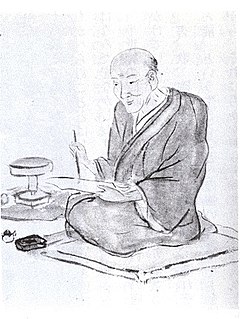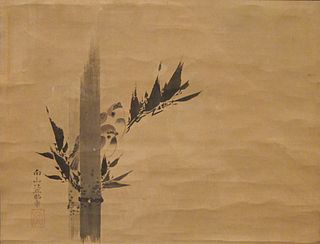 W
WBaisao (1675–1763) was a Japanese Buddhist monk of the Ōbaku school of Zen Buddhism, who became famous for traveling around Kyoto selling tea. The veneration of Baisao during and after his lifetime helped to popularize sencha tea and led to the creation of the sencha tea ceremony.
 W
WHakuin Ekaku was one of the most influential figures in Japanese Zen Buddhism. He is regarded as the reviver of the Rinzai school from a moribund period of stagnation, refocusing it on its traditionally rigorous training methods integrating meditation and koan practice.
 W
WTōrei Enji (東嶺円慈) was an eminent Japanese Zen Buddhist monk, teacher, author, painter and calligrapher. He was the chief disciple and Dharma heir of famed Japanese Rinzai master Hakuin Ekaku (1685-1786) and was a major figure in the revival of the Rinzai school in eighteenth century Japan. He is also known as the author of an influential text on Zen practice called "The Undying Lamp of Zen", which is his magnum opus and presents the comprehensive system of Rinzai Zen as it existed at the time of Hakuin.
 W
WEnkū (円空) (1632–1695) was a Japanese Buddhist monk, poet and sculptor during the early Edo period. He was born in Mino Province and is famous for carving some 120,000 wooden statues of the Buddha and other Buddhist icons, many of which were given in payment for lodging on his pilgrimages to temples throughout Japan.
 W
WEmperor Go-Mizunoo was the 108th Emperor of Japan, according to the traditional order of succession. Go-Mizunoo's reign spanned the years from 1611 through 1629, and was the first emperor to reign entirely during the Edo period.
 W
WHon'inbō Sansa was the assumed name of Kanō Yosaburō , one of the strongest Japanese Go players of the Edo period (1603–1867), and founder of the house of Hon'inbō, first among the four great schools of Go in Japan. He was a Buddhist priest of the Nichiren sect, and his original dharma name was Nikkai (日海).
 W
WHōzōin Kakuzenbō In'ei was a Buddhist monk and sōhei, abbot of Hōzōin temple, and guardian of all the temples of Nara. He is famous for having founded a school of Sōjutsu called Hōzōin-ryū in 1560s.
 W
WImakita Kōsen was a Japanese Rinzai Zen rōshi and Neo-Confucianist.
 W
WIngen Ryūki was a Chinese poet, calligrapher, and monk of Linji Chan Buddhism from China. He is most known for founding the Ōbaku school of Zen in Japan.
 W
WIshin Sūden also known as Konchiin Sūden, was a Zen Rinzai monk and advisor to Tokugawa Ieyasu, and later to Tokugawa Hidetada and Iemitsu on religious matters and foreign affairs. He played a significant role in the initial development of the Tokugawa shogunate.
 W
WKeichū (契沖) was a Buddhist priest and a scholar of Kokugaku in the mid Edo period. Keichū's grandfather was a personal retainer of Katō Kiyomasa but his father was a rōnin from the Amagasaki fief. When he was 13, Keichū left home to become an acolyte of the Shingon sect, studying at Kaijō in Myōhōji, Imasato, Osaka. He subsequently attained the post of Ajari at Mount Kōya, and then became chief priest at Mandara-in in Ikutama, Osaka. It was at this time that he became friends with the poet-scholar Shimonokōbe Chōryū.
 W
WMatsudaira Tadanao was a Sengoku to early Edo period Japanese samurai, and the 2nd daimyō of Fukui Domain in Echizen Province.
 W
WMatsudaira Harusato was a Japanese daimyō of the mid-Edo period, who ruled the Matsue Domain. He was renowned as a tea master, under the name Matsudaira Fumai .
 W
WNichiō was a Nichiren Buddhist who founded the Fuju-fuse subsect. His sect was founded when he refused to attend funeral services for Hideyoshi. The regent Tokugawa Ieyasu subsequently exiled him to Tsushima.
 W
WObaku Dokuryu (1596–1672) was a Japanese calligrapher, scholar, monk and artist.
 W
WOhatsu (お初) or Ohatsu-no-kata (お初の方) was a prominently placed figure in the late Sengoku period. She was daughter of Oichi and Nagamasa Azai, and the sister of Yodo-dono and Oeyo. Alongside her sisters, she was active in the political intrigues of her day. Ohatsu's close family ties to both the Toyotomi clan and the Tokugawa clan uniquely positioned her to serve as a conduit between the rivals. She acted as a liaison until 1615 in the siege of Osaka, when the Tokugawa eliminated the Toyotomi.
 W
WŌtagaki Rengetsu was a Buddhist nun who is widely regarded to have been one of the greatest Japanese poets of the 19th century. She was also a skilled potter and painter and expert calligrapher.
 W
WRikei was a Japanese noble lady, calligrapher, poet and scholar. She was the eldest daughter of Katsunuma Nobutomo, a samurai of the Sengoku period. She lived as a nun on Daizen-ji temple at Mount Kashiwao and is most notable for her military history, Rikei-ni no Ki, or "Nun Rikei’s Account."
 W
WSakai Hōitsu was a Japanese painter of the Rinpa school. He is known for having revived the style and popularity of Ogata Kōrin, and for having created a number of reproductions of Kōrin's work.
 W
WSengai Gibon was a Japanese monk of the Rinzai school. He was known for his controversial teachings and writings, as well as for his lighthearted sumi-e paintings. After spending half of his life in Nagata near Yokohama, he secluded himself in Shōfuku-ji in Fukuoka, the first Zen temple in Japan, where he spent the rest of his life.
 W
WShōkadō Shōjō was an Edo period Buddhist monk, painter, calligrapher and master of the tea ceremony. He is one of the "Three brushes of the Kan'ei period" .
 W
WTakuan Sōhō was a Japanese Buddhist prelate during the Sengoku and early Edo Periods of Japanese history. He was a major figure in the Rinzai school of Zen Buddhism. Noted for his calligraphy, poetry, tea ceremony, he is also popularly credited with the invention of the takuan pickled radish.
 W
WTenkai was a Japanese Tendai Buddhist monk of the Azuchi-Momoyama and early Edo periods. He achieved the rank of Daisōjō, the highest rank of the priesthood. His Buddhist name was first Zuifū (随風), which he changed to Tenkai in 1590. Also known as Nankōbō Tenkai , he died on 13 November 1643, and was granted the posthumous title of Jigen Daishi (慈眼大師) in 1648.
 W
WTeruko, Princess Ake was a Japanese imperial princess and artist. She was the eighth daughter of Emperor Go-Mizunoo.
 W
WYokoi Kinkoku , a disciple of Yosa Buson, was a famous Japanese poet and painter from the Edo period. He was also a Buddhist monk.
 W
WBankei Yōtaku was a Japanese Rinzai Zen master, and the abbot of the Ryōmon-ji and Nyohō-ji. He is best known for his talks on the Unborn as he called it. According to D. T. Suzuki, Bankei, together with Dogen and Hakuin, is one of the most important Japanese Zen masters and his Unborn Zen is one of the most original developments in the entire history of Zen thought.